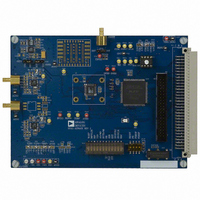EVAL-AD7679CB Analog Devices Inc, EVAL-AD7679CB Datasheet - Page 15

EVAL-AD7679CB
Manufacturer Part Number
EVAL-AD7679CB
Description
BOARD EVAL FOR AD7679
Manufacturer
Analog Devices Inc
Series
PulSAR®r
Specifications of EVAL-AD7679CB
Number Of Adc's
1
Number Of Bits
18
Sampling Rate (per Second)
570k
Data Interface
Serial, Parallel
Inputs Per Adc
1 Differential
Input Range
±VREF
Power (typ) @ Conditions
89mW @ 500kSPS
Voltage Supply Source
Analog and Digital
Operating Temperature
-40°C ~ 85°C
Utilized Ic / Part
AD7679
Lead Free Status / RoHS Status
Contains lead / RoHS non-compliant
CIRCUIT INFORMATION
The AD7679 is a very fast, low power, single-supply, precise
18-bit analog-to-digital converter (ADC) using successive
approximation architecture.
The AD7679’s linearity and dynamic range are similar or better
than many Σ-Δ ADCs. With the advantages of its successive
architecture, which ease multiplexing and reduce power with
throughput, it can be advantageous in applications that
normally use Σ-Δ ADCs.
The AD7679 provides the user with an on-chip track/hold,
successive approximation ADC that does not exhibit any
pipeline or latency, making it ideal for multiple multiplexed
channel applications.
The AD7679 can be operated from a single 5 V supply and can
be interfaced to either 5 V or 3 V digital logic. It is housed in a
48-lead LQFP, or a tiny 48-lead LFCSP that offers space savings
and allows for flexible configurations as either a serial or
parallel interface. The AD7679 is pin-to-pin compatible with
the AD7674, AD7676, and AD7678.
CONVERTER OPERATION
The AD7679 is a successive approximation ADC based on a
charge redistribution DAC. Figure 23 shows the simplified
schematic of the ADC. The capacitive DAC consists of two
identical arrays of 18 binary weighted capacitors that are
connected to the two comparator inputs.
REFGND
REF
IN–
IN+
262,144C 131,072C
262,144C 131,072C
MSB
MSB
Figure 23. ADC Simplified Schematic
Rev. A | Page 15 of 28
4C
4C
2C
2C
During the acquisition phase, terminals of the array tied to the
comparator’s input are connected to AGND via SW+ and SW–.
All independent switches are connected to the analog inputs.
Thus, the capacitor arrays are used as sampling capacitors and
acquire the analog signal on IN+ and IN– inputs. When the
acquisition phase is complete and the CNVST input goes low, a
conversion phase is initiated. When the conversion phase
begins, SW+ and SW– are opened first. The two capacitor
arrays are then disconnected from the inputs and connected to
the REFGND input. Therefore, the differential voltage between
the IN+ and IN– inputs captured at the end of the acquisition
phase is applied to the comparator inputs, causing the
comparator to become unbalanced. By switching each element
of the capacitor array between REFGND and REF, the
comparator input varies by binary weighted voltage steps
(V
switches, starting with the MSB first, to bring the comparator
back into a balanced condition. After completing this process,
the control logic generates the ADC output code and brings the
BUSY output low.
REF
C
C
/2, V
REF
C
C
/4...V
LSB
LSB
REF
SW+
SW–
COMP
/262144). The control logic toggles these
SWITCHES
CONTROL
CONTROL
LOGIC
CNVST
OUTPUT
03085–0–025
BUSY
CODE
AD7679




















